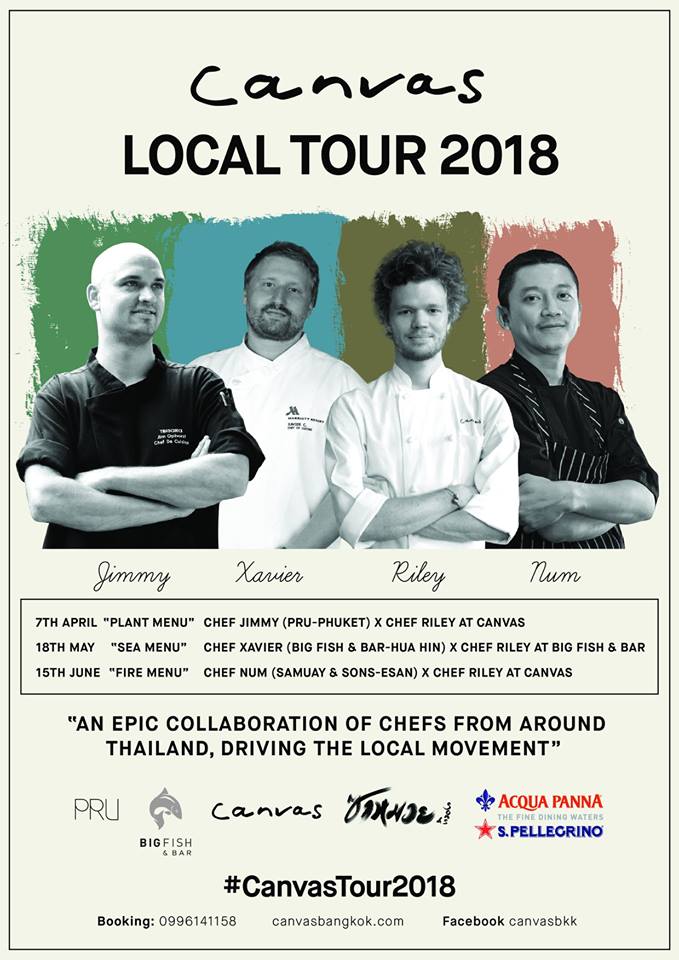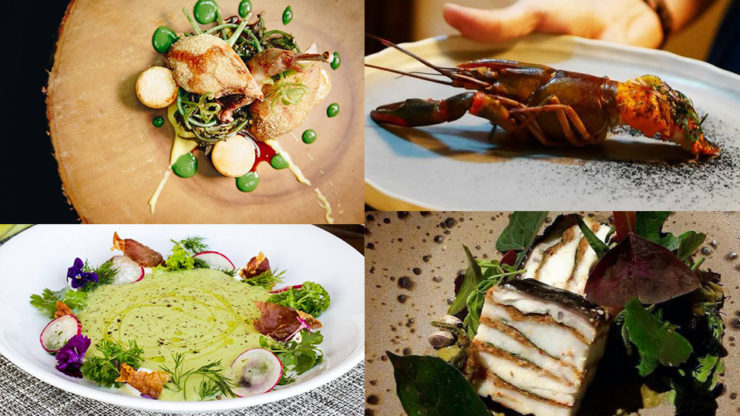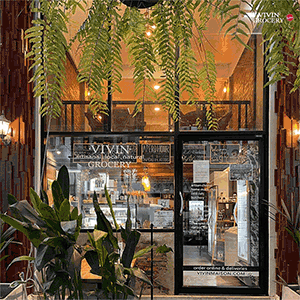Same Same but Different – Eclectic “Thai” Cuisine Rising
Chefs in Thailand driving the Local Thai Ingredients Movement into Contemporary Fine Dining
We’ve all heard of the “fusion confusion” when describing two distinct ethnic foods combined into one dish. Fusion popped up since the 70s, branded as new-age cuisine where it become a new genre unto itself, and have been haunting classically trained chefs ever since. The idea behind fusion was to offer diners a taste of two or more of distinct cultures in one dish. While some people feel it was and is an abomination, there are scores of foodies who continue to indulge in a multicultural palate. Yay! “We are the world, we are the future”. The fact is, although it appears confusing, fusion is often clearly definable
Whereas a new perplexing movement of cuisine is beginning to rise, not only in the heart of the culinary scene in Bangkok, but in all provinces of Thailand, a number of young (and young at hand) chefs have devoted themselves to using solely homegrown Thai ingredients to create dishes that are not distinctly Thai, nor entirely International or even Asian. Probably the closest would be “Contemporary”, “Modern” or “Eclectic”. By its sheer nature, using Thai herbs, roots, vegetables, meat and fish produce will inherit a Thai taste, but by creating unique and complex reconstruction of these ingredients, the lines become blurred but the results are often outstanding.
The biggest challenge these new wave of chefs who are producing intricate meals at a Michelin standard are facing is the justification of using “all-local” ingredients into the casual fine dining category, and therefore, the fine diner’s mindset. There’s also the challenge of consistency in produce and seasonal ingredients. Slowly but surely, times are beginning to change, thanks to chefs like Riley Sanders of Canvas, Jim Ophorst of Pru Restaurant Phuket, Xavier Charest of Big Fish & Bar Hua Hin and Weerawat Triyasenawat (Num) of Samuay & Sons in Esan. Bangkok Foodies was able to tap into the minds of these locally driven chefs.
You can also see these chefs in action for the Canvas Local Tour 2018, an epic 3 part series 4 hands dinner at 2 locations.
BKF: What made you decide to go in the direction of locally driven ingredients in casual fine dining?
Riley: Excitement about the ingredients available here and possibilities of using them in different ways than they’ve been traditionally used.
Jim: The closer to home, the fresher the products! Thailand has many beautiful undiscovered produce.
Xavier: Encourage you to learn new things, the most interesting part of cooking: Being creative
Num: It seems like these days we almost forget our roots, so using local produce is one of the things that can remind us who we are.
BKF: Thai produce often gets a bad wrap in fine dining, as it was considered too common or inferior in quality compared to imported product. Do you see if this attitude has changed much?
Riley: Slowly, and the restaurants focusing on local ingredients contribute to that, along with the farmers offering quality produce.
Jim: Sure it does, with all the small organic farmers who see that hard work pays of. Also, because we are in Thailand. We can work with the produce that is from here.
Xavier: There are still areas where people prefer ingredients from Europe and America. They think that these products are far superior. However, the attitudes towards Thai local ingredient are changing in a positive way. People are more open-minded now, we just need to continue supporting the idea of using local products.
Num: Absolutely, I have seen both farmer and cook sharing what they need to each other to make things better. I know it is not there yet but very soon, we will see the difference.
BKF: Can you strictly call your cuisine “Thai” food and if not, how would you classify it?
Riley: Local ingredient driven.
Jim: Definitely not Thai food, we call it ‘modern creative farm-to-table cuisine’ with the best locally-sourced produce available.
Xavier: Cooking with love!
Num: I would say my cooking is Thai with local produce and wisdom influence.
BKF: What are some of the biggest challenges of working with local ingredients vs the benefits of working with local ingredients in casual fine dining cuisine?
Riley: Sourcing the highest quality ingredients is the biggest challenge, and the ability to be creative and think differently about them is the biggest benefit.
Jim: Finding the right consistency of products and discovering unknown ingredients. You can get it fresh every day, compare to products from Europe where you can get it maximum twice a week. The fish is in front of my doors for example!
Xavier: The biggest challenge is to find local supplier who can supply ingredients with consistent quality. Therefore, the solution is not to control how much products we need from farmers, as it is very difficult to control the weather condition. Instead, we just take whatever he can produce and create the new dished based on what was available. The obvious benefit is we get the super fresh ingredients straight from the farm.
Num: Consistency! I would say that since the season keeps changing all the time.This makes it very challenging, but in the end, it gives us more flavour profile to experiment more, to find the right techniques for the ingredients.
BKF: What are the reactions of Thai and Western diners after trying your food? Are they often perplexed?
Riley: We get a wide range of reactions, mostly they’re surprised and excited.
Jim: People are surprised that all of this is created with Thai ingredients.
Xavier: They were really excited and interested in the new concept of local food. The most satisfying part is to see how they were blown away with the unexpected Ingredients.
Num: Opening the restaurant with this concept in my hometown was not easy. Most people raised their eyebrow when they taste our dish and started questioning what are we doing. Now they totally appreciate what we do.
BKF: In the creative process of creating dishes, do you try to find inspiration from classic Thai dishes or you’re really starting from a clean slate?
Riley: We take a bit of inspiration, but use that more as a reference point towards doing something new or creative. We don’t do any “plays” on Thai food, we’re not trying to compete with Thai food. Thai food is amazing… Ours is just different.
Jim: As my food isn’t Thai, I don’t get inspiration by traditional food, but I take inspiration from new unknown ingredients from those classic dishes, and from there on, I start to create my own identity.
Xavier: Food is like fashion, it’s the circle that we always come back to. I certainly got my inspiration from classic food (Thai or Western). We never entirely create something new, the basic is already there. We only improve and add the new perspective of cooking based on the ingredients we have on hands.
Num: I use everything around me for my inspiration. More than that, I try to represent the terroir from my region.
BKF: What qualities do you look for in sourcing and foraging for local produce?
Riley: Fresh, unique, grown with care and responsibility, seasonal.
Jim: It has to be fresh, of course, and second, it has to be different than what I know of. We have discovered a lot, but there is still a lot more to discover out there.
Xavier: The passion from the person who makes this local ingredient. I’m not looking for the best product, instead I’m looking for a nice story and someone with lots of pride in what he does.
Num: Seasonal, sustainable and organic local stuff, that’s what we look for.
BKF: What are some of the most interesting local ingredients you have worked with and what were the dishes?
Riley: The really wild stuff we haven’t played with much yet. There are some things we’ve gotten that no one on our staff has seen before, and the Thai cooks aren’t able to find out any more info. That may be a strangely sour fruit or a very bitter herb.
Jim: The first unknown ingredient I discovered was the Dahla flower in the jungle of our farm. This opened up my eyes and by this day it’s in one of my desserts. (Also the dessert that I will be cooking at Canvas).
Xavier: Mix wild mushrooms growing with coffee bean, small project I make with one of my farmer friend.
Num: There are so many amazing local ingredients in my region that I have been cooking with, but right now I would say “wild ginger” (khing pa). The first bite will make you think about Krachai so you keep chewing it then the flavour turns to really ginger-like and give you the cool sensation on your throat and chest…super cool stuff for me.
BKF: Why is the locally grown philosophy so important in cuisine and what do you think of the the “Thai but not Thai” category of cuisine for the future?
Riley: It’s what makes sense. I think ingredients will continue to be looked at differently as cuisines, diners, and chefs evolve moving forward.
Jim: Everything that is closer to home will be fresher. 20-30 years ago we only ate local produce and the trend returned a few year ago. So, I think this will always be there.
Xavier: Because it is the best way to cook, always respect the product. Local products certainly have the benefit of freshness. I just have to find the way to bring out the flavours of these ingredient as much as possible.
Num: My goal is to preserve biodiversity and local wisdom to hand it to the next generation and that’s everything to me.Thai cuisine to date is totally different from Thai cuisine in the past, to me, Thai cuisine has been developing itself since 300 years ago until now.
BKF: How can the public support the movement or be more aware of what they are consuming with local products? The benefits and even the dangers? Local market hygiene and pesticides for example.
Riley: Visit the restaurants promoting local products, speak with the chefs, research local farms, markets, and producers.
Jim: I think there is a big movement going on, but there is still a lot of room to improve. The farmers should get more attention of what they are doing. At Pru, we always pay them more and this will result in a cleaner farm produce, etc.
Xavier: Create awareness of the pride of using local products. There are so many nice ingredients that are still uncovered or not widely used. Thai people should be proud of what they have because the fresh ingredients are really the best flavors.
Num: It is difficult for the people even now to find the good quality local product. So that is what one of our goal, to tell our guests where the ingredients come from to promote the local produce for those who look for these information.
BKF: Do you find people are reluctant to pay more for dishes made from all-local produce and is it a misconceptions that they are cheap and easy to come by?
Riley: This seems to be happening less. We really try to interact with the guests, educate them, explain how we’re sourcing and looking at the ingredients here, and putting that all together in a dish. So, we’re giving them an experience, and that’s something very valuable.
Jim: If it’s good, they are willing to pay more. I always tell the farmers if you give me an amazing organic product, I will pay you double the price of what it is in the market. You don’t pay for local produce, you pay for the hard work of those who made it possible for you to have this produce! They deserve more.
Xavier: People are willing to pay more for the special experience. Many Thais I have met are very proud and willing to support the ideas of having their local ingredients turned into a nice fancy dish.
Num: Yes it’s true about this attitude, but it seems less and less.The first thing that we have to fix is the farmer’s mindset. I have seen so many farmers that grow such beautiful produce, but they sell it for so cheap and the reason they put the price like that was because their produce was too local. They have to be proud of themselves and the rest will fall into place.

Canvas
Between Thonglor Soi 5 & 7, (opposite Tops Supermaket)
Klongton Nua, Wattana, Bangkok 10110
Tel: 099 614 1158
Facebook/IG: Canvas / Canvasbkk



